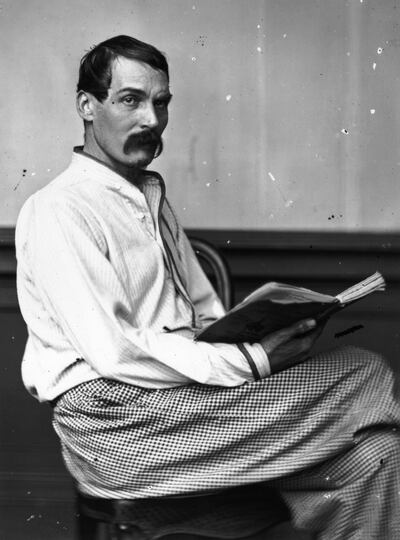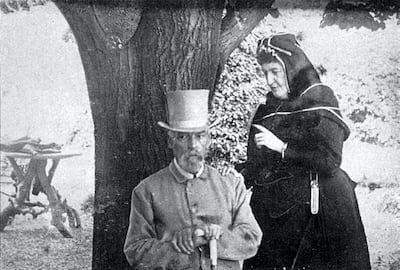For more than a century, the Bedouin tent carved from stone in the graveyard of a Roman Catholic church in London, drew little more than a glance from curious passers-by.
The mausoleum in the UK capital's south-western suburb of Mortlake is the final resting place of the colourful Victorian explorer Sir Richard Burton and his wife Isabel Arundell, and a permanent reminder of their love of expeditions across the Middle East.
Both were buried there in the late 19th century – and as their fame faded into the history books, the mausoleum fell into a state of disrepair.
When it was targeted by vandals, who smashed its stained glass window in the 1970s, the tomb in the grounds of St Mary Magdalen church was sealed permanently.
For nearly 50 years the coffins and numerous trinkets entombed were visible only by climbing a steel ladder and peering through a tiny window in the roof.
But now, with the launch of a £30,000 ($41,118) restoration campaign, its caretakers are hoping to open the door once again and give visitors a glimpse into the lives of the couple.
“Burton was a fascinating character who travelled the world and, as a result, the mausoleum is an amalgamation of very overt Islamic and Christian symbolism,” said Emily Lunn, the project manager for Habitats and Heritage, the charity overseeing the Grade II listed monument.
“It is a real representation of the two characters buried inside and their genuine love of Syria and the wider Middle East.”
Carved from sandstone to echo the effect of canvas rippling in the wind and modelled on the tent Burton used during expeditions in the Syrian desert, it was designed by Arundell as an homage to the region.
Around its pelmet, sitting under two Stars of Bethlehem and an ornate marble crucifix, are dozens of gilt-painted Islamic crescent and star symbols.
While the mausoleum’s exterior seems anomalous alongside the more traditional tombstones in the church’s graveyard, its now dilapidated interior is even more unusual.
Syrian camel bells, which once jangled when the door was opened to announce a visitor, are strung from the beams. Glass lamps and artefacts from the couple’s travels in the Middle East are dotted around the white Tuscan marble floor surrounding their coffins, while an altar at one end features bronze serpents and the walls are adorned with Christian iconography.
The explorer, who was born in Torquay, in south-west England in 1821, travelled to Mumbai at the age of 22 with the army of the East India Company.
He went on to lead expeditions to East Africa, primarily to find the source of the Nile – before serving as consul in West Africa, Brazil, Damascus in Syria and Trieste in Italy.
Arundell, whom he married in 1861, often accompanied him on trips and was determined to match his adventurous spirit.
“She kept house in Damascus and went on an expedition to Palmyra with him," Ms Lunn said.
“They were some of the first Europeans to visit and took a caravan.”
In the course of his travels, Burton became fluent in 29 languages – 40 if dialects are included – and could easily converse in Arabic, Hindi, Marathi and Punjabi, among many.
He was so adept at assimilating that he would often pose as a trader called Mirza Abdullah.
In one of his most daring expeditions, he went to Makkah and Madinah in 1853 and performed Hajj, disguised as a Muslim sheikh.
It was never clear if he had converted to Islam, partly because Arundell burnt his diaries after he died.
Historian Dane Kennedy, who wrote a biography of Burton, said he was not Muslim.
But Burton had a "sense of appreciation for all of these different faiths and traditions, rooted in an historical appreciation of the way in which they provided a sense of order, identity, coherence and cohesion for a particular group of people", Mr Kennedy said.
Burton wrote extensively about his expeditions, publishing 43 travelogues, as well as translating Arabic texts such as the One Thousand and One Nights.
His book, Personal Narrative of a Pilgrimage to El-Medinah and Meccah was devoured by a Victorian audience hungry for tales of an exotic, faraway land.
The explorer died of a heart attack in Trieste in 1890, followed by Arundell in 1896.
When Burton was buried in June 1891, 400 mourners lined the streets of Mortlake to pay their respects and to catch a glimpse of his extraordinary tomb. It was paid for by the public purse, costing the equivalent of about £188,000 ($257,729) in today's money.
But after years of neglect, the mausoleum fell into a state of disrepair. It is now on Historic England's "at risk" register and in desperate need of rescue work.
The roof has deep cracks, allowing water to seep in to its interior and lichen is beginning to creep up from its York stone foundations.
Ms Lunn said: “It is looking rather drab and needs essential maintenance work.
“We want to give it a limewashing to brighten it again, repair any cracks to stop water ingress and give it a very sensitive clean, so that people will be able to go into the mausoleum once again."
She said Burton had much to teach visitors today about "exploring without boundaries", particularly at a time when the Covid-19 pandemic has curtailed travel.




